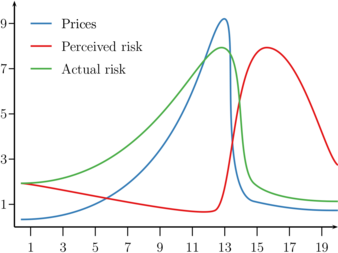85:
112:. Shown in the figure on the right, as a financial asset enters into a bubble state, followed by a crash, perceived risk reported by typical risk measures, falls as the bubble builds up, sharply increasing after the bubble deflates. By contrast, actual risk increases along with the bubble, falling at the same time the bubble bursts. Perceived risk and actual risk are negatively correlated. The phenomenon is often explained by use of Danielsson's dam metaphor.
20:
65:. Market participants react to these shocks, but have no influence over them. By contrast, endogenous risk is risk stemming from the behaviour of participants within the financial system, such as when positive economic outlooks cause innovation of new financial products, increased leverage, and speculation; these self-reinforcing processes feed on each other to increase risk. Such endogenous factors,
249:
91:
A dam is a good illustration of actual and perceived risk. Before the dam breaks, risk is perceived as low, and we leave the dam as it is. After the dam breaks, risk is perceived as high, and we institute crisis measures. The endogenous or actual risk in the system is the opposite of the perceived
92:
risk: when tensions build up before the dam breaks, actual or endogenous risk in the system is high and growing, amplified by self-reinforcing weaknesses. After the dam has broken, actual or endogenous risk in the system is low.
49:
Risk can be classified into the two categories of exogenous and endogenous. Exogenous risk is risk stemming from factors outside the financial system, such as
286:
96:
As a practical interpretation of endogenous risk when applied to risk measurements, it can be further subdivided into
279:
84:
38:
that is created by the interaction of market participants internal to the financial system. It was proposed by
224:
Danielsson, J.; Shin, H. S.; Zigrand, J. P. (2012). "Endogenous extreme events and the dual role of prices".
305:
70:
310:
272:
50:
142:
121:
109:
180:
162:
256:
154:
74:
62:
54:
19:
43:
39:
35:
158:
299:
105:
78:
210:
66:
166:
31:
58:
248:
141:
Danı́elsson, Jón; Shin, Hyun Song; Zigrand, Jean-Pierre (2004-05-01).
104:
what is reported by common risk measurement techniques, such as
260:
143:"The impact of risk regulation on price dynamics"
280:
8:
207:Global Financial Systems: Stability and Risk
287:
273:
83:
18:
133:
7:
245:
243:
61:, which may have severe effects on
259:. You can help Knowledge (XXG) by
255:This finance-related article is a
122:Supply chain network risk analysis
14:
247:
147:Journal of Banking & Finance
100:the underlying latent risk, and
69:and Shin claim, are behind most
181:"When risk models hallucinate"
81:is a form of endogenous risk.
77:. They further claim that all
1:
159:10.1016/S0378-4266(03)00113-4
327:
242:
89:Danielsson's dam metaphor:
23:Actual and perceived risk
205:Danielsson, Jon (2013).
93:
24:
87:
51:political instability
22:
34:risk, is a type of
110:expected shortfall
94:
25:
268:
267:
213:. pp. 40–60.
55:natural disasters
318:
289:
282:
275:
251:
244:
234:
233:
221:
215:
214:
209:(1st ed.).
202:
196:
195:
193:
192:
177:
171:
170:
153:(5): 1069–1087.
138:
75:financial crises
28:Endogenous risk,
326:
325:
321:
320:
319:
317:
316:
315:
296:
295:
294:
293:
240:
238:
237:
226:Annu. Rev. Econ
223:
222:
218:
204:
203:
199:
190:
188:
179:
178:
174:
140:
139:
135:
130:
118:
102:perceived risk;
17:
12:
11:
5:
324:
322:
314:
313:
308:
306:Financial risk
298:
297:
292:
291:
284:
277:
269:
266:
265:
252:
236:
235:
216:
197:
172:
132:
131:
129:
126:
125:
124:
117:
114:
44:Hyun-Song Shin
40:Jon Danielsson
36:financial risk
30:as opposed to
16:Financial risk
15:
13:
10:
9:
6:
4:
3:
2:
323:
312:
311:Finance stubs
309:
307:
304:
303:
301:
290:
285:
283:
278:
276:
271:
270:
264:
262:
258:
253:
250:
246:
241:
232:(1): 111–129.
231:
227:
220:
217:
212:
208:
201:
198:
186:
182:
176:
173:
168:
164:
160:
156:
152:
148:
144:
137:
134:
127:
123:
120:
119:
115:
113:
111:
107:
106:value at risk
103:
99:
90:
86:
82:
80:
79:systemic risk
76:
72:
68:
64:
60:
56:
52:
47:
45:
41:
37:
33:
29:
21:
261:expanding it
254:
239:
229:
225:
219:
206:
200:
189:. Retrieved
187:. 2024-02-03
184:
175:
150:
146:
136:
101:
98:actual risk;
97:
95:
88:
63:asset prices
48:
27:
26:
73:and severe
71:tail events
300:Categories
191:2024-06-02
128:References
67:Danielsson
167:0378-4266
46:in 2002.
32:exogenous
116:See also
59:pandemic
211:Pearson
57:, or a
165:
257:stub
185:CEPR
163:ISSN
108:and
42:and
155:doi
302::
228:.
183:.
161:.
151:28
149:.
145:.
53:,
288:e
281:t
274:v
263:.
230:4
194:.
169:.
157::
Text is available under the Creative Commons Attribution-ShareAlike License. Additional terms may apply.

